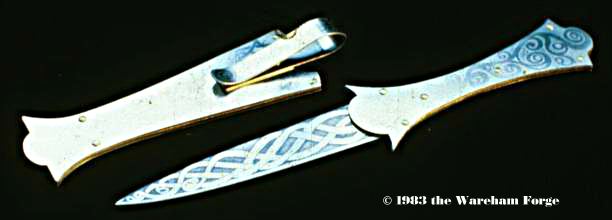>I just recently picked up a couple or norseish handaxes (cold steel Viking
>throwing axes) and I was wondering what would have been considered
>decoration for a hand axe.
...
>I am considering carving runes in the handles and maybe trying my hand at
>acid etcing the sides of the blades but am looking for ideas.
If you want to get fussy about it, acid etching is not a technique used during the Viking Age. The stronger acids used in our modern age did not exist at this point in time. The first true acid etched pieces using a resist then chemical bath to create a surface decoration date to the mid 1300's.
This is setting aside the problem of pattern welding. Still significant discussion about if Dark Ages pattern welded blades where etched or not - and if so using what chemicals. Things like urine, salt water or vinegar all work to a certain extent, but those are more discolouring than truly creating a topographic etch.
That being said, depending on how you use the acid etch method, it can be a visual substitution for engraving - which definitely IS seen on VA metalwork. Engraving is a higher level of skill and requires specialized tools. You are carving the metal away with small chisels. During the VA a popular extension of engraving was to cut small channels in the base metal then hammer in thin strips of gold or silver into the grooves.
I had done a huge amount of decorative acid etching years back - both on steels and on copper alloys (even silver). Here is a very fast overview of the technique:
I would recommend using a liquid tar resist that you paint on. Grab some roofing tar and thin out with varsol (only) to thickness about like white glue. This lets you quickly cover surfaces, plus paint lines and leave clear areas. After it drys, you can use a probe to scratch in line breaks (for interlace) or fine details.
Any of the historic colouring books can be good reference. "Viking Design' by my friend A.G. Smith is especially good (as it remains extremely accurate to the artifact originals). If you do your layout lines on the metals using a fine water based marker, you can gently wash the surface and remove the lines before etching.
Any of the acids available at your hardware will work. All produce toxic fumes, so work on a windy day and out of doors. Speed of cut will depend on metal and the type and most important strength of acid mix. Nitric is no longer easily available, but Muriatic (hydrochloric) or battery acid (sulphuric) will work. At the lower strengths sold in hardware stores you likely will not need to dilute. You should make a test etch to check cutting rate first!
REMEMBER - ALWAYS ADD ACID TO WATER - NEVER THE OTHER WAY ROUND.
Absolutely wear safety eye wear (full face shield recommended )
An alternative is to use ferric chloride, used for etching circuit boards. Much safer, no fumes, but does cut much slower.
As the metal etches, use a bid feather to brush away the bubbles (flammable hydrogen) that form for a clean surface.
Generally carbon steels will cut MUCH faster than copper alloys. Depending on metal and acid, in the range of five minutes or less.
Neutralize the final etch using baking soda. I just mix up a paste and rub it on after the metal has been well flushed with water. (In fact, work with running water or a basin handy, its the easiest and safest way to prevent skin burns.)
This is a sample of the technique:

a commercial knife blade, re profiled and fitted with a german silver hilt and scabbard. The patterns flow from blade to hilt to scabbard.
(Anyone ancient of days and from the SCA Middle Kingdom may remember the 'Segmented Crowns'. The base level technique for ornamentation was acid etching. )




















2 comments:
I always liked that piece.
I know that this is old, but for those of you just finding this: If you get acid on your skin (especially something like concentrated hydrochloric or sulfuric acid) wipe it off with a dry cloth FIRST before running water over it. At lower concentrations it wont do much, but at higher concentrations rinsing it from your skin with water will cause burns from boiling water/acid
Post a Comment